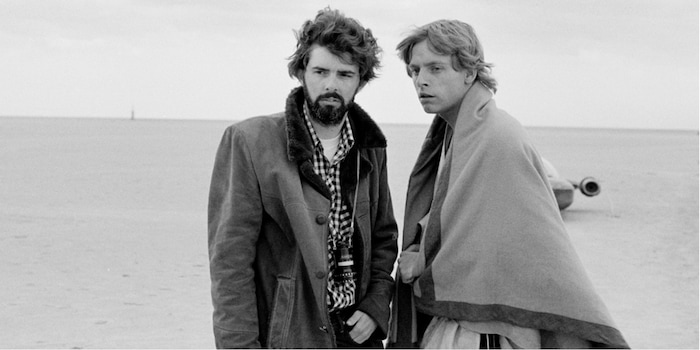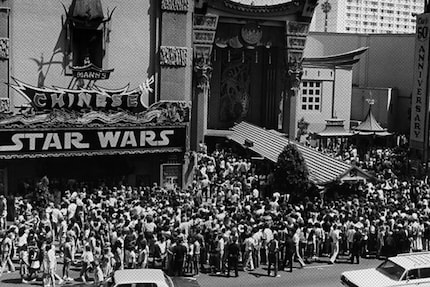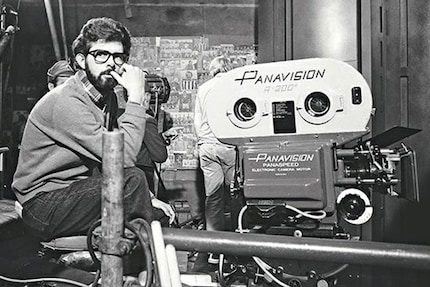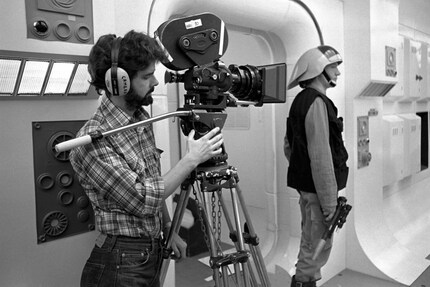
And cut! George Lucas' empire strikes back
You think only screenwriters can write good stories? No way! Curiosities, funny anecdotes and all sorts of crazy things about cinema and filmmaking - that's what this is all about. Today: When "Star Wars" inventor George Lucas cheated the studio out of billions.
May 1977: The term "blockbuster" is born. Hundreds of people queue outside American cinemas to see "Star Wars". The queues are now so big that they span dozens of blocks - a blockbuster, after all.
This is happening because only a few cinema operators believed in the success of the space opera and the film is not showing everywhere where there is a projector and screen. What's more, people are talking to each other. About the breathtaking opening, accompanied by the triumphant fanfares from John Williams' pen, about Jedi warriors, lightsabres and the fastest shotgun in the galaxy.
They talk about the film that founded modern filmmaking.
The man behind "Star Wars" is George Lucas, and his success has been a legendarily rocky odyssey of challenges and opposition. Even his closest friends from their student days - including illustrious names and later directing legends such as Martin Scorsese and Brian De Palma - advised him against the project because they thought masked men with breathing difficulties were nonsense.
But: Lucas owes everything he has achieved to a single, very clever move.
The battle for "Star Wars"
George Lucas had the idea for "Star Wars" back in 1971. The first version of his work was called "The Journal of the Whills". In it, Han Solo is a reptilian alien creature and Luke Skywalker is an old Jedi general who is still called Luke Starkiller. In later versions, he calls his work "The Star Wars". There Luke is given his now familiar surname, but he introduces a certain Annikin Starkiller to the teachings of the Jedi Bendu. Years pass before the story takes on the form we know today.
And yes, the Starkiller base in "Star Wars - The Force Awakens" is actually an Easter egg.

Source: Dark Horse Comics
In 1973, two years later, Lucas celebrated his first cinema hit with "American Graffiti". The film is not only celebrated by critics, but also grosses a whopping 140 million dollars on a budget of just one million dollars. A success that opens doors for George Lucas. Especially those to a galaxy far, far away - even if not right away. The idea of a classic coming-of-age tale in space was not initially convincing.
In the mid-1970s, the film landscape is characterised by a cynical world: the Vietnam War, the Watergate scandal and the energy crisis have left their mark. But the success of "American Graffiti" earned Lucas respect, and he won at least one valuable fan: Alan Ladd Jr, executive producer at 20th Century Fox. Ladd convinces the studio to finance the film despite major reservations.
You know the rest: "Star Wars" becomes the biggest cinema success of all time at the time, a global cultural phenomenon and, thanks to companies founded specifically for the film such as Industrial Light & Magic (ILM) or THX were founded specifically for the film and also set the tone audiovisually for the way films would be made from then on.

A blockbuster, after all.
The brilliant move by George Lucas
But the story doesn't end there. Because the success of "Star Wars" not only gave Lucas a Hollywood career, it even made him more money than the studio itself. An impossible feat, but Lucas pulled off a brilliant move.

In the summer of 1975, contract negotiations with 20th Century Fox are going badly. In the end, the studio agrees to finance the film and offers Lucas a salary of 500,000 dollars.
George Lucas refused, however, and countered with an unexpected offer: he agreed to make the film for just 150,000 dollars and at the same time forgo a large part of the income from ticket sales. In return, however, he would receive all rights to further Star Wars films, as well as the rights to merchandise and licence deals. The studio, which doubts the success of the project and any further Star Wars films anyway, readily agrees.
What are merchandise and licence deals? In this context, the trade in toys, fan accessories and pretty much anything even remotely related to the film. Back then, it was a niche market at best, the mere mention of which was a waste of time.




There's nothing that doesn't exist. "Star Wars" merchandise is simply everywhere, even today.

In hindsight, Fox would have liked to have slapped himself in the face. Because since its cinema release 40 years ago, the first "Star Wars" has grossed an inflation-adjusted 2.9 billion dollars - only "Gone with the Wind", "Avatar" and "Titanic" have grossed more money to date after adjusting for inflation. But it's nothing compared to what George Lucas has hoarded.
During his 35 years at the helm of the "Star Wars" empire, according to The Hollywood Reporter, he raked in $12 billion from the sale of Star Wars toys and other merchandising. The five sequels that Lucas produced himself also earned him a respectable fortune. Together, they generated 3.5 billion dollars at the cinema box office, 4 billion dollars from the sale of DVDs and VHS tapes, 3 billion dollars from video game sales, 2 billion dollars from books and comics and a further 1.3 billion dollars from licensing rights.
All in all, Lucas has earned over 25 billion dollars with the "Star Wars" brand, not including the 4.05 billion dollars for the sale to Disney. How did he come up with the idea of thinking so far ahead?
When you're at the beginning of your directing career, you're constantly fighting for survival. To survive and to be able to make the next film.
So the motivation was this: Even if "Star Wars" flopped at the box office, he would have the opportunity to finance further sequels, to which he already owned the rights, thanks to toy sales.

The studios have learnt their lesson. Today, "Star Wars" is the reason why they always endeavour to keep the merchandising rights for themselves. After all, they all want to earn 12 billion dollars from toys.
Do you know a hair-raising story or funny anecdote about cinema or filmmaking? Then write it in the comments or send me an email. Maybe it's exactly your story that I'll tell in the next "And cut!" issue.
I write about technology as if it were cinema, and about films as if they were real life. Between bits and blockbusters, I’m after stories that move people, not just generate clicks. And yes – sometimes I listen to film scores louder than I probably should.
Interesting facts about products, behind-the-scenes looks at manufacturers and deep-dives on interesting people.
Show all